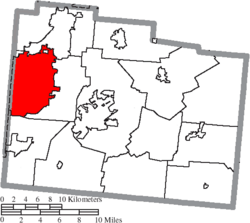Beavercreek, Ohio facts for kids
Quick facts for kids
Beavercreek, Ohio
|
|
|---|---|

From top left, left to right: The Greene Town Center, 9/11 Memorial, Aerial view of northern Beavercreek, Little Beaver Creek, Beavercreek High School
|
|

Location of Beavercreek in Greene County
|
|
| Country | United States |
| State | Ohio |
| County | Greene |
| Incorporated | 1980 |
| Area | |
| • Total | 26.63 sq mi (68.96 km2) |
| • Land | 26.59 sq mi (68.88 km2) |
| • Water | 0.03 sq mi (0.08 km2) |
| Elevation | 873 ft (266 m) |
| Population
(2020)
|
|
| • Total | 46,549 |
| • Estimate
(2023)
|
47,193 |
| • Density | 1,750.36/sq mi (675.83/km2) |
| Time zone | UTC-5 (Eastern (EST)) |
| • Summer (DST) | UTC-4 (EDT) |
| ZIP codes |
Zip codes
|
| Area codes | 937, 326 |
| FIPS code | 39-04720 |
| GNIS feature ID | 2394102 |
Beavercreek is a city in Greene County, Ohio, United States. The population was 46,549 at the 2020 census, making it the largest city in the county and the second-largest suburb of Dayton.
The Beavercreek area was settled in the early 1800s. A part of Beavercreek Township was incorporated and became the City of Beavercreek in February 1980. Many Beavercreek residents work at nearby Wright-Patterson Air Force Base. In 2007, Beavercreek ranked 84th in Money's Top 100 places to live.
Contents
Geography
Beavercreek is approximately five miles east of downtown Dayton.
According to the 2010 census, the city has a total area of 26.44 square miles (68.5 km2), of which 26.40 square miles (68.4 km2) (or 99.85%) is land and 0.04 square miles (0.10 km2) (or 0.15%) is water.
Beavercreek includes the former unincorporated communities of Alpha, Knollwood, most of New Germany, and Zimmerman.
Demographics
| Historical population | |||
|---|---|---|---|
| Census | Pop. | %± | |
| 1980 | 31,589 | — | |
| 1990 | 33,626 | 6.4% | |
| 2000 | 37,984 | 13.0% | |
| 2010 | 45,193 | 19.0% | |
| 2020 | 46,549 | 3.0% | |
| 2023 (est.) | 47,193 | 4.4% | |
| Population 1980-2000. | |||
2010 census
As of the census of 2010, there were 45,193 people, 18,195 households, and 12,542 families residing in the city. The population density was 1,711.9 inhabitants per square mile (661.0/km2). There were 19,449 housing units at an average density of 736.7 per square mile (284.4/km2). The racial makeup of the city was 88.5% White, 2.5% African American, 0.2% Native American, 5.9% Asian, 0.5% from other races, and 2.3% from two or more races. Hispanic or Latino of any race were 2.6% of the population.
There were 18,195 households, of which 30.0% had children under the age of 18 living with them, 58.9% were married couples living together, 6.8% had a female householder with no husband present, 3.2% had a male householder with no wife present, and 31.1% were non-families. 24.9% of all households were made up of individuals, and 8% had someone living alone who was 65 years of age or older. The average household size was 2.47 and the average family size was 2.98.
The median age in the city was 40.4 years. 22.6% of residents were under the age of 18; 8.5% were between the ages of 18 and 24; 24.8% were from 25 to 44; 29.6% were from 45 to 64; and 14.3% were 65 years of age or older. The gender makeup of the city was 49.9% male and 50.1% female.
Recreation
The Beavercreek City Parks department operates and maintains 23 parks and other properties.
Beavercreek Station is a hub along Creekside Trail, a bike path that stretches from Xenia to Eastwood MetroPark in Dayton.
Education
Beavercreek City School District consists of 6 elementary schools, 2 middle schools, a separate ninth grade campus, and 1 high school. Beavercreek has a public library, a branch of the Greene County Public Library.
Transportation
The Greater Dayton Regional Transit Authority provides bus service in the city.
Notable people
- Taylor Ewert, long-distance runner and track and field athlete
- Aftab Pureval, attorney and politician, 70th mayor of Cincinnati
- Janet C. Wolfenbarger, former Commander, Air Force Materiel Command and the first female four-star general of the United States Air Force
See also
 In Spanish: Beavercreek (Ohio) para niños
In Spanish: Beavercreek (Ohio) para niños



